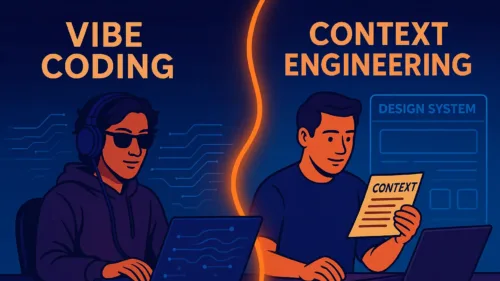Vibe Coding vs. Context Engineering

A while back, I wrote In Defense of Vibe Coding – an argument for creativity, for accessibility, and for giving people permission to build without worrying if the code was perfect.
I still stand by that. In fact, I love vibe coding! It’s how ideas start. It’s how imagination becomes visible. It’s how we sketch the future before we commit to building it.
But lately, I’ve noticed something interesting.
Every time someone uses AI to generate code, tweak a component, or spin up an interface, they call it “vibe coding.” And I don’t feel like that’s quite right.
We’re starting to lump two very different disciplines into the same bucket, and in doing so, we’re blurring a boundary that really matters.
Vibe Coding Is the Sketch
Vibe coding is about expression, not execution.
It’s that burst of creativity when you open Bolt, Lovable, or Cursor and just start building. You don’t know exactly where you’re headed, but that’s the point. You’re following a hunch, testing a layout, chasing a concept.
It’s the pencil sketch before the painting. The early composition on the canvas.
There’s beauty in that imperfection. It’s playful, fast, and inclusive, the moment where builders of all backgrounds can participate in creation, not just consumption.
But a sketch, no matter how inspired, isn’t the finished portrait.
At some point, you have to decide: is this idea strong enough to bring to life properly?
When it is, that’s when the work of context engineering begins.
Context Engineering Is the Craft
Context engineering isn’t a sequel to vibe coding; it’s a discipline of its own.
It’s what happens when you bring structure, semantics, and intent to the table, not vibes.
You can start a project with context engineering from day one. For example, when we build Context-Based Design Systems at Southleft, we often use AI to transition components from Figma to codebases. The AI gets it maybe 50-80% right on average, depending on the complexity of the component. That’s fine. It’s not about perfection.
What happens next isn’t vibe coding, it’s context engineering.
Experienced developers step in. They understand the framework, the architecture, the tokens, the properties… They contextualize the AI’s output. They use their judgment and domain expertise to bring the component the rest of the way — manually, methodically, and intelligently.
AI stays in the loop, but it’s guided by engineered context rather than open-ended prompts.
This process could start from a sketch, or it could start from a spec. The key is that context engineering applies a structured mindset: one that balances automation with intention.
The Relationship Between the Two
Vibe coding and context engineering are not steps on a single ladder. They’re parallel tracks that can intersect, but don’t depend on each other.
- Vibe coding inspires ideas.
- Context engineering realizes them.
- Vibe coding invites everyone to play.
- Context engineering requires skill, patience, and technical literacy.
- Vibe coding asks, “what if?”
- Context engineering asks, “how, exactly?”
Sometimes, a project begins as a vibe-coded experiment that gets “ejected” into a real codebase, where engineers apply context to refine it. Other times, context engineering is there from the very start, like a blueprint built with care and precision, before a single line of code is generated.
Why the Distinction Matters
When we call everything “vibe coding,” we flatten the craft.
We risk implying that all AI-assisted development is casual, unstructured, or chaotic — when in fact, there’s a whole other class of work happening quietly behind the scenes: highly skilled engineers designing systems that teach AI to behave responsibly, consistently, and contextually.
Context engineering deserves its own name because it’s its own practice.
It’s what separates creative generation from intelligent production.
It’s how great systems, not just great sketches, come to life.
In Praise of Both
Vibe coding and context engineering aren’t rivals. They’re complementary forces in the same creative ecosystem.
Vibe coding is freedom. Context engineering is focus.
One starts the story. The other finishes it.
Vibe coding is the sketch.
Context engineering is the craft.
Both have value. But they’re not the same, and the sooner we start naming that difference, the more intentional our AI-driven work will become.
